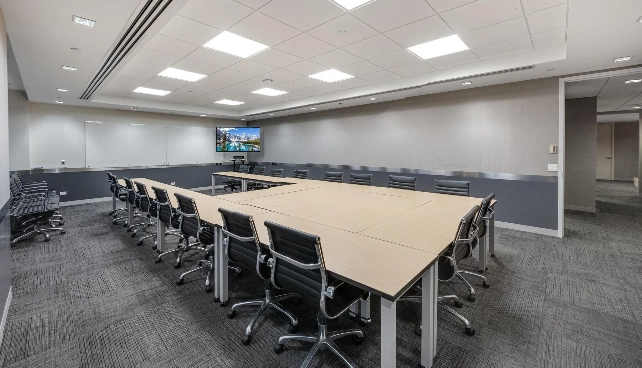You can run a good meeting by preparing ahead of time, setting a clear agenda and providing opportunities for clear communication. Engaging meeting attendees with interactive discussions is another way to run a good meeting.
Workplace meetings are an essential part of working together productively as a team. If your business involves at least two people, holding meetings provides a number of benefits, including the ability to discuss company updates and work through problems. A good meeting is one that has been planned out ahead of time and includes a clear agenda that is designed to accomplish specific goals.
What’s Considered a Good Meeting?
A good meeting is usually considered one that is productive and has a clearly defined goal. Holding a meeting for the sake of holding a meeting is a waste of time, so any workplace meeting you plan should have an agenda. Productive meetings involve presenting and discussing topics that encourage action on the part of attendees.
Key Ingredients to a Successful Meeting
There are a number of key ingredients required for a successful meeting, including a clear agenda and defined objectives. Below are some of the most crucial elements needed for a successful workplace meeting:
Clear Agenda
A clear agenda keeps everyone who is attending a workplace meeting on the same page. Without a clear agenda, meeting discussions can wander and get off-topic. This leads to wasted time and lowered productivity.
Active Participation
Active participation is another key ingredient in a successful meeting. When meeting attendees actively participate in discussions during workplace meetings, they feel more invested in the outcome of these discussions.
Additionally, active participation encourages everyone to share their views on the topics being discussed. This can surface new ideas and call attention to innovative thinking.
Effective Communication
Effective communication is essential for a good meeting because communication is at the heart of workplace meetings. Every person presenting during a meeting needs to be able to speak without interruption, be provided with the appropriate technology to communicate with meeting participants and have an allotted time to speak according to a meeting schedule.
Time Management
A good meeting relies on time management to ensure that all items on an agenda are covered. Failure to set and follow an agenda or meeting schedule could mean that a meeting runs long because topics become jumbled. While it may make sense to appoint a meeting attendee to keep track of the time, digital tools can be used to track time and topics as well.
Defined Objectives
Good meetings have objectives, and even if you aren’t able to achieve those objectives during a meeting, the meeting itself should work toward your objectives. If objectives can’t be met during a single meeting, you can schedule another one, but it’s a good idea to keep notes from previous meetings and review them before holding future meetings. This prevents workplace meetings from covering the same topics over again.
Collaboration
Collaboration during workplace meetings can bring employees closer together, make meeting attendees feel valued and provide a platform for new ideas and opinions to be shared. Some workplace meetings rely on break-out sessions in which groups of employees meet separately to discuss granular topics. After a period of time, all meeting attendees regroup to discuss their results as they pertain to a larger central topic.
Decision-making
If possible, make decisions during workplace meetings. The benefit of decision-making during a meeting is that everyone can be informed of any decisions made to avoid redundancy or misinformation in the future. Recording your meetings helps to ensure that everyone can review all decisions made, and your recordings can serve as a record in the event that a dispute about a decision comes up later.
Follow-up Actions
When necessary, determine follow-up actions during each meeting. If people who need to be followed up with are not in attendance, make it a point to record your meeting or take detailed notes to provide to these people after the meeting has concluded.
Engaged Participants
Engaged participants in a workplace meeting are more likely to share ideas and opinions. Participant engagement also encourages inclusiveness and makes employees feel like part of a team. This benefit can go on to promote productivity in the workplace.
Respectful Environment
A respectful environment is a must during workplace meetings. Attendees should have appointed times to speak or ask questions, and interruptions or disruptions should not be tolerated. If you find it necessary, consider drafting a code of conduct to be provided to meeting attendees to help enforce meeting policies.
Types of Meetings
Meetings can be held for a variety of reasons, and how often you hold meetings will be determined by the needs of your business. Below are some common types of meetings and the reasons for holding them:
Board Meetings
Board meetings are generally meetings held to discuss high-level decisions that need to be made by stakeholders in a business or organization. For example, a board of directors may meet once per quarter to discuss financials and decide on funding opportunities for business partnerships.
Team Meetings
Team meetings are held to discuss department-level topics and usually include all members of a team or select members from a team’s leadership. During these meetings, general workplace topics can be discussed, but topics directly affecting the team in attendance should take precedence.
Staff Meetings
Staff meetings are workplace meetings that involve staff from all levels or management and different departments. These types of workplace meetings are general in nature and may cover topics like changes to workplace policies, decisions that will affect all employees or new products and services that a company will offer in the future.
Client Meetings
Client meetings are held between a business and its clients. These meetings may involve providing clients with status updates on a project’s progress, but they can also involve answering questions a client has regarding ongoing projects. Onboarding new clients generally requires at least one meeting to get a new project started, and some businesses will also hold meetings to debrief a client at the end of a project.
Brainstorming Sessions
A brainstorming session is a type of meeting in which attendees are encouraged to participate in thinking of new ideas. These meetings can involve personnel from different departments and management levels in a company, but they are often highly participatory in nature.
Project Meetings
A project meeting is a type of workplace meeting during which ongoing or upcoming projects are discussed. During these meetings, individuals and teams may be invited to attend, and a project meeting may cover general topics related to a project.
Some topics covered during a project meeting may include the overall goals of a project and the resources available for the project. Detailed sub-topics related to a project may also be discussed, including things like schematics for a manufacturing project or programming language discussions for a software development project.
One-on-One Meetings
One-on-one meetings are workplace meetings that are held between two people. In most cases, these meetings involve a superior and a subordinate. An example of a one-on-one meeting is a performance review during which an employee’s supervisor meets to discuss the employee’s performance or address specific topics the employee needs to be made aware of.
Training Sessions
Training sessions are meetings that engage workers in training. These types of meetings can be held during the onboarding process of a new hire, during team training for new company-wide initiatives or for specific purposes when a company begins to use new tools and resources.
Virtual Meetings
Virtual meetings are meetings that are held in real time but in a virtual environment. Most virtual meetings are held over the Internet using voice-over-IP (VoIP) technologies like Google Meet and Zoom video conferencing.
The benefit of a virtual meeting is that these meetings can be hosted from anywhere an Internet connection is present. This means they can bring together remote teams or teams working from virtual offices around the world.
Status Meetings
Status meetings are similar to project meetings in that they are designed to discuss the status of an ongoing project or initiative. The difference is that a status meeting is meant to only discuss the status of project actions whereas a project meeting may involve discussions about anything related to a project.
Benefits of Good Meetings
Good meetings yield a number of benefits for companies and teams in all industries. Below are some of the biggest reasons to strive for good meetings:
Increased Productivity
A good meeting will typically result in increased productivity. When everyone in a meeting has access to the same information, all workers can be on the same page about policies, initiatives and expectations.
Clear Communication
Good meetings result in clear communication, not just among team members, but also between departments and business locations. In a sense, good meetings “clear the air” about important topics so that everyone understands what’s going on and can stay informed.
Team Building
Team building can result from good meetings, especially when employees are encouraged to actively participate. When employees are able to speak and voice their opinions on a meeting’s topic, they feel valued and more like a member of a team.
Efficient Problem-Solving
The phrase “two heads are better than one” certainly rings true when it comes to workplace meetings and productivity. Problems in the workplace can often be solved with greater productivity when workers are able to meet in a group to discuss solutions.
Alignment and Accountability
A good meeting also promotes alignment of ideals and expectations as well as accountability for each employee’s role in a project. Good meetings do not publicly call out employees for poor performance, but instead, they offer encouragement to staff while addressing performance issues overall. It’s generally best to address individual employee performance concerns during one-on-one meetings.
Preparation for a Good Meeting
Because preparation is such a vital part of putting together a good meeting, business owners are encouraged to take steps ahead of time to plan out meetings before they are in session. Below are some considerations to keep in mind when making preparations for a good meeting:
Establishing a Clear Objective
Have a central theme or topic to discuss during your meeting. This keeps everyone on track, and it can help attendees prepare to discuss topics ahead of time.
Setting an Agenda and Time Limit
Setting an agenda, time limit and schedule for your meetings will help them to run more smoothly. How rigid you need to be with your meeting agenda or schedule is up to you, but it’s a good idea to try to stick to your agenda as closely as possible to avoid your meeting devolving into chaos where nothing productive is accomplished.
Developing Ground Rules
Ground rules or meeting policies should be in place so that all attendees understand how to participate. You can draft these policies and provide them in a handout prior to your meeting, but it may also be a good idea to briefly cover them at the start of each meeting.
Inviting the Right Participants
You want to invite the right participants to your meeting if you plan to be productive. For example, if your meeting is being held to discuss concerns in the sales department, inviting your head of sales and any sales department managers to your meeting would be ideal.
Preparing Action Items and Action Plans
Having action items or an action plan in place before your meeting can provide attendees with clear guidance about what to do with the information discussed during a meeting. Action items may include specific steps that need to be taken based on decisions made during a meeting, but they can also be more general in nature.
During the Meeting
During a meeting, whether held virtually or in the office, distractions and interruptions should be kept to a minimum. Only one person should be recognized to speak at a time, and an agenda should be followed to keep the meeting on-topic and on-time.
Running the Meeting Effectively
In order to run a meeting effectively, you should consider assigning roles. For example, someone should be responsible for keeping time when each attendee speaks so that everyone has a chance to voice their opinion.
You can also assign someone the role of tech support to operate recording equipment or video conferencing tools. When people have assigned roles, you’ll spend less time trying to figure out your next steps and more time being productive.
Frequently Asked Questions
The following are some frequently asked questions and answers about how to run good meetings:
What are the 5 P’s of effective meetings
There are five concepts that make good meetings: Preparation, purpose, process, performance and payoff. Although these “five Ps” apply to most meetings, other variables should be considered based on your industry and goals.
What are the 4 P’s of meetings
Some businesses follow four principles of good meetings known as the “four Ps”. These include purpose, product, people and process. How effective these concepts are to your meetings will depend on what you are trying to achieve.
What is the 40 20 40 rule for meetings
The 40-20-40 rule for meetings states that you should spend 40% of your time preparing for and planning your meeting, 20% of your time in the actual meeting itself and 40% of your time analyzing the ideas and discussions generated by the meeting.
What are the three main phases of a good meeting
A good meeting typically has three phases that include preparation, action and follow-up. Each of these phases should be given equal attention, but some business owners use the 40-20-40 rule instead. This rule places more emphasis on the preparation and follow-up phases of a meeting.
What is a meeting checklist
A meeting checklist is an itemized checklist of topics to discuss and items to address during a meeting. These checklists can be used to ensure all of the topics of a meeting are covered and that no important topics are missed during discussions.
How to start a meeting
You can start a meeting by planning a day and time when all attendees are available. Virtual meetings can be started using software, and some virtual meetings can start automatically for attendees once the meeting organizer has initiated the software.
How do you structure a meeting
Meetings can be structured by making a list of topics to discuss and creating goals around these topics. A workplace meeting can have an agenda that lays out a series of topics to discuss in order to reach a pre-defined goal.
What are the 4 C’s vs the 4Ps
The four Cs and four Ps describe sets of words that are used in a marketing matrix for business. The four Cs include customer, cost, convenience and communication. The four Ps include product, price, place and promotion.
It should be noted that the four Cs describe a more customer-focused approach to marketing compared to the four Ps. Either concept can be used to shape meetings involving the discussion of marketing initiatives.
What is the golden rule of a meeting
Different companies and industries ascribe a “golden rule” to meetings, but you can have more than one golden rule. Some golden rules include: Having a clear agenda, only holding necessary meetings and following up on important items after a meeting has concluded.
What is the 2 minute rule in meetings
The two-minute rule in meetings is a general rule that states each participant must be given two minutes of uninterrupted time to speak when they are provided the floor. During this time, questions should be withheld unless the speaker specifically asks for attendee participation.
How to run good meetings in the workplace
You can run good meetings in the workplace by planning ahead of time and having a clearly defined agenda and goal for each meeting.
Looking for an office in the city? Corporate Suites offers furnished office spaces, virtual offices & conference rooms in several prestigious locations across New York City.






